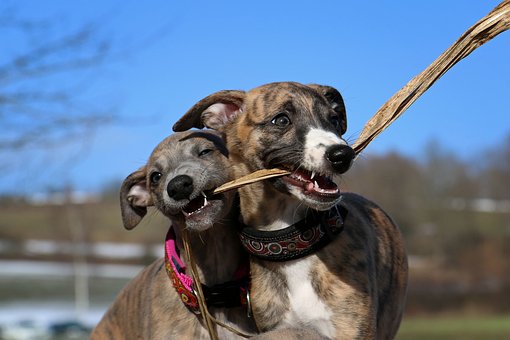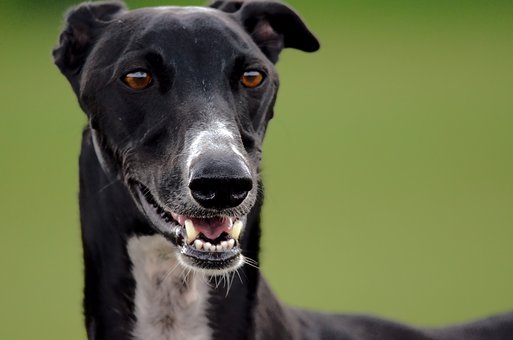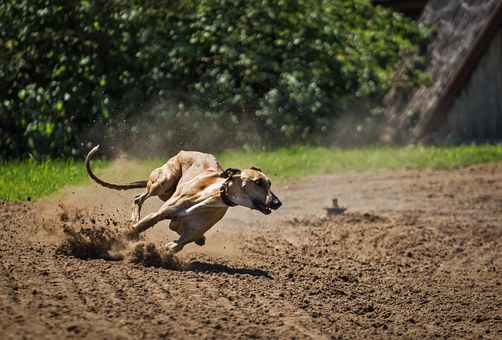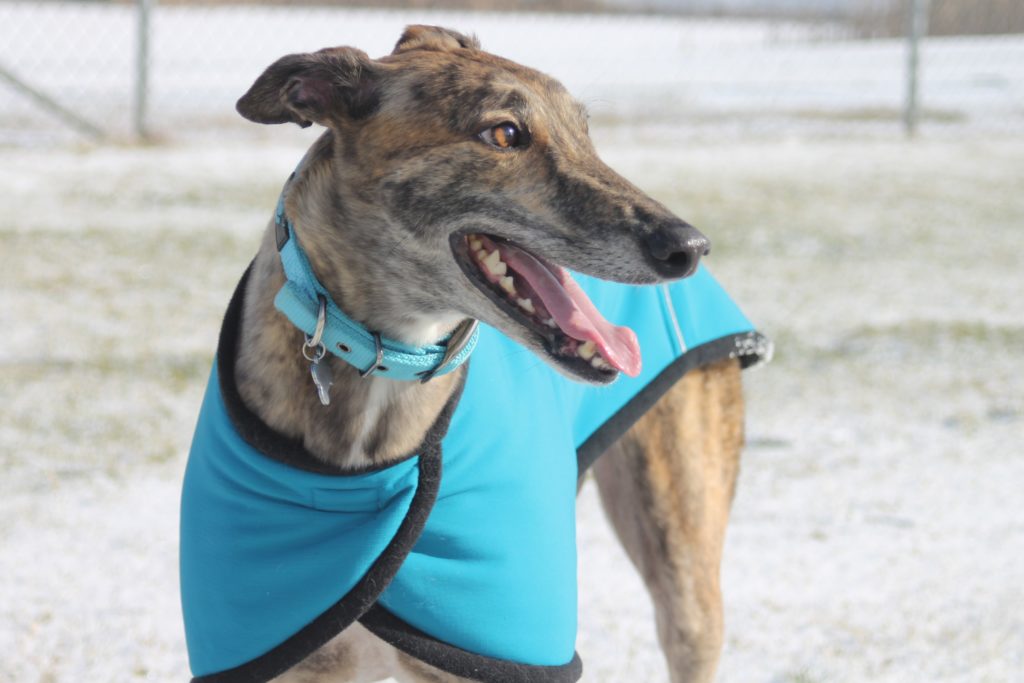Generally a fairly healthy breed, the Italian Greyhound is still susceptible to a fair amount of health problems. While much of how healthy your dog is will depend on whether or not he is a retired racer, many health conditions are actually hereditary. However, any dog, no matter how health its line, can encounter problems at some point in his life.
This post will go over some common Greyhound health issues so that you may be prepared if your dog becomes ill. Not all Greyhounds will deal with these issues, but it’s good to be aware of these conditions if you’re considering bringing home a Greyhound, or already have one.
Common Greyhound Health Problems
Bone Cancer (Osteosarcoma)
Among the more serious Greyhound health issues is Osteosarcoma, which is an aggressive form of bone cancer. Greyhounds actually have a high rate of developing osteosarcoma, with cancer typically affecting one of the dog’s legs. Osteosarcoma in dogs will require aggressive treatment to keep it from being fatal, which will usually require the amputation of the affected leg and chemotherapy.
If caught early enough, the dog could live on for some time after amputation, but if not, this form of cancer is almost always fatal. The first sign of osteosarcoma is lameness, so don’t hesitate to bring your dog to the vet if he develops a limp.
Gastric Torsion (Bloat)

At first glance, you might think bloat is a minor condition and nothing to worry about. After all, we’ve all felt bloated before after a big meal, and the feeling passed after we had time to digest, right?
However, bloat in dogs can actually be fatal, and death can happen fast. And more worrisome still is the fact that Greyhounds are much more likely than other breeds to bloat.
A Greyhound becomes bloated when a sudden influx of gas and air enters the dog’s stomach, causing it to expand. A bloated dog can encounter gastric torsion when its stomach twists in on itself, cutting off blood flow.
When it occurs, gastric torsion will strike suddenly, and the dog can go from perfectly fine one minute to dead just a few hours later.
The twist in the stomach that gastric torsion causes will require immediate emergency surgery to save the dog. The symptoms to watch out for in your dog include drooling, an inability to purge, signs of pain, abnormal restlessness and pacing, pale gums and licking its lips. Unfortunately, having bloat and gastric torsion once makes a Greyhound more susceptible to it happening again. However, there is a procedure known as “stomach tacking” that helps stop the stomach from twisting in the future. It might be a good idea to have it done as a preventative measure should your dog encounter this serious Greyhound health issue.
Eye Disease – Pannus
Greyhounds are one of a few breeds that are known to develop an eye condition called Pannus, which can lead to blindness if it goes untreated. Commonly thought to be an inherited condition, Pannus typically starts to appear when the dog is around two to five years old. When a Greyhound develops Pannus, the edge of the dog’s cornea will seem more pigmented than it was before, almost looking like freckles on the edge of the eye, or a hazy-gray color.
If allowed to progress, the condition will grow onto the surface of the eye and grow inwards until it covers the eye, not allowing any light to enter the eye, which causes blindness. There is no cure to completely eliminate Pannus once it has started, but its progression can be slowed through daily eye drops and cortisone injections.
Sensitivity To Anesthesia
Most Greyhounds, like all other sighthounds, are sensitive to anesthesia and some other medications. Doses of anesthesia that would be normal for another dog around the same size could actually kill a Greyhound. The reason for this most likely has something to do with the Greyhound’s low percentage of body fat, but this has yet to be confirmed. Greyhounds also are known to be greatly stressed during trips to the vet or if they need to be hospitalized, which may also play into their sensitivity.
Regardless, make sure your veterinarian is aware of the breed’s sensitivity to anesthesia before undergoing any kind of treatment so they know to give an appropriate dosage than they normally would for a dog their size.
Hypothyroidism

Hypothyroidism is a condition in which the thyroid gland does not produce enough hormones. Regular production is vital to a dog’s health because it controls their metabolism.
When their thyroid is underactive, it typically means their metabolism will be slower than normal, and the dog could gain weight.
Beyond obesity, the main symptoms of hypothyroidism include lethargy, droopy eyelids, low hormone levels, mental slowness, and irregular heat cycles. In some cases, hypothyroidism has been known to cause infertility.
Sometimes the dog’s fur will also become coarse and brittle and even fall out, revealing tough, dark skin. Thankfully, Greyhound’s with hypothyroidism can still live a full and happy life if they are treated. Healthy Greyhounds may also have lower-than-normal thyroid readings, so your veterinarian should be familiar with Greyhound health anomalies.
Heart Murmurs
All dogs are susceptible to some form of a heart condition, but Greyhounds, in particular, are prone to developing minor heart murmurs. This is because they quite literally have big hearts, and often have high blood pressure. Heart murmurs in dogs are often minor but should be monitored to make sure they don’t turn into something worse. They are also often misdiagnosed as heart disease when none is present if the vet is unfamiliar with what is normal for a Greyhound.
Sensitivity To Cold
Because Greyhounds have little-to-no insulation on their bodies, they simply cannot tolerate cold weather. The have ultra-thin coats on top of their skinny frames that contain almost no body fat, so if you live in a cold climate area, make sure you have a sweater for your dog for when you go outside.
Hip Dysplasia
Thankfully, the Greyhound is one of few breeds that is rarely ever affected by canine hip dysplasia. In fact, it’s relatively unheard of in this breed. If you ever notice your dog developing a limp, become stiff, or seem reluctant to go up and down stairs or move around, there is most likely something else bothering him, so bring your dog into the vet to get checked out.
Health Conditions Found In Racing Dogs

There are many non-hereditary health risks that come along with adopting a retired racing dog. These can range from dental problems to bloody and crumbling toenails, some of which will require immediate attention after you receive the animal.
Take your adopted dog to the veterinarian to check for any dental issues, as they may be hard to detect.
The Greyhound’s damaged nails and frequently cracked and broken paw pads can be soothed through foot soaks, and other therapies that aim to eliminate bacteria and fungus while promoting healthy paws. Toenail and pad issues are extremely common in racing Greyhounds.
Retired racer Greyhounds should also be given a complete tick disease panel, because many retired racers have had infections at some point, or may even currently be infected. Tick diseases are usually easily treatable with antibiotics if caught early, so make sure to have your adopted dog tested right away just in case. While you’re at it, it’s also a good idea to test for heartworm, although your adoption group should have done this already.
How To Prevent Greyhound Health Problems
Of course, a healthy diet and consistent exercise throughout your dog’s life are the best things you can do as an owner to help prevent your dog from developing any health problems. But sadly, nothing is guaranteed, and even despite your best efforts, any animal can still get sick. That’s not meant for you to use an excuse or to deter you from maintaining a healthy routine for your dog at all — quite the opposite in fact. You should still do everything in your power to ensure your Greyhound has a long, happy, healthy life.
But beyond that, what can you do? For starters, you should do everything you can to look into your Greyhound’s health history before you bring him home. This goes for both puppies and retired racing dogs — you should be able to check on the history for reach.
When getting a puppy, the first thing you want to do is make sure you’re getting your dog from a reputable breeder. They should be able to produce documentation that proves the dog is healthy and comes from a line without a history of developing any major hereditary conditions. These clearances will show you that the puppy has been tested and cleared for several health issues.
With regard to Italian Greyhound health issues in particular, you will want to see health clearances for hypothyroidism, hip and elbow dysplasia (from the Orthopedic Foundation for Animals), and Von Willebrand’s disease. They should also have addition confirmations from the Canine Eye Registry Foundation (CERF) to certify that the dog’s eyes checked out normal.
Reputable breeders will be members of the Greyhound Club of America and have their animals registered with the Canine Health Information Center (CHIC). Their puppies must pass heart evaluations and submit a blood sample before they can be given a CHIC number, however keep in mind that receiving a number is not a declaration of good health.

Any dog that goes through the process, even those that do not pass or receive good scores, will receive a number. But all test results, whether positive or negative, are published in the CHIC database for you to check on the health history of a puppy’s parents. Breeders should carefully screen their Greyhounds and only breed their healthiest and best-looking dogs.
It’s impossible to predict whether or not a dog will develop any health issues later in life, and not all conditions can be detected in a growing puppy.
Puppies can develop health issues even if they come from the healthiest of lines, but choosing a reputable breeder who is committed to proper breeding practices at least gives you the best foundation for a healthy dog.
If you’re adopting a retired race dog, you may still be able to find some documentation on the dog’s health history and line, but in other cases, you might have a bit of a wildcard. Racing dogs are not required to be tested eye conditions and heart diseases, as breeders are only concerned with speed. Thus, a proven winner with a good pedigree will be bred.
This is not at all a declaration that you are more likely to get an unhealthy dog by adopting, it just means you will potentially be without any proof of having a healthy family line. The main thing with adopted race dogs is to maintain their weight.
Since they were racing dogs, your pup is used to more activity than your typical dog, so you will need to maintain a healthy diet and exercise regimen for your champion athlete. Your dog will appreciate the TLC they receive from living in a loving family home but are used to ripping down the racetrack, so you’ll need to make sure you find time for your dog to run!
Remember that after you’ve taken a new puppy into your home, you have the power to protect him from one of the most common health problems: obesity. Keeping a Greyhound at an appropriate weight is one of the easiest ways to extend his life. Make the most of your preventive abilities to help ensure a healthier dog for life.




